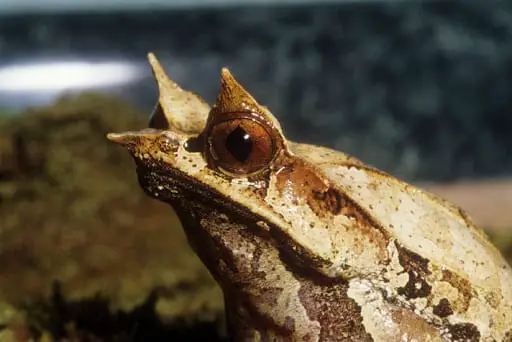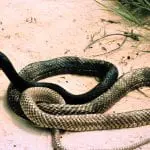Scientific Facts
| Common Name: | Malayan Horned Frog |
| Scientific Name: | Megophrys nasuta |
| Life Span: | 5 years or longer |
| Length: | 3 inches to 6 inches |
| Habitat: | Forest floors and moving streams |
| Country of Origin: | Thailand and Malaysia |
Physical Description
Malayan Horned Frogs are known for their striking color that is perfect for camouflage. Their skin is filled with red, black, brown, and tan spots to mimic leaves. Additionally, they have pointed noses to look much like the leaves, too. They are also distinguishable from the horn-like shape above their eyes, which is also an evolutionary defense mechanism to veer away from the most common outline of a frog.
The Malayan horned frog is also a little larger in size in comparison to other species. The females are larger at about 5 inches or more, while the males are slightly smaller at 3.5 inches in length. Almost all the Malayan horned frogs that are taken from the wild are found to be males, so being able to see a female will be such a wonder to behold due to their enormous sizes.
Conservation Status
According to the IUCN Red List, the Malayan horned frog is a species of least concern, as of the last assessment dated August 1st, 2014.
Life Span
There is not much data available on how long the Malayan horned frogs live, but it said to be an average of 5 years, or longer, in ideal captive care.
Availability and Natural Habitat
Originally, the Malayan horned frogs can be found living in Singapore, Malaysia, Indonesia, and Thailand. The natural areas where they live are lower areas of the forests. They prefer being covered by the forest floor cover, and the leaf litters around. Malayan horned frogs utilize this space as a way to wait for their prey and sneak into their attack. These horned critters reside fairly close to forest streams that are clean, clear, and fast-moving, which they mostly use for their breeding.
Diet
Malayan horned frogs love eating dubia roaches, pinhead crickets, black soldier flies, hornworms, pinkie mouse, and melanogaster fruit flies.
For pet horned frogs in captivity, their prey items must be dusted with supplements for vitamins and minerals. D3 supplements and calcium supplements are what these frogs need the most. The supplements must be stored in airtight containers in the refrigerator and replaced every six months. For older and more matured Malayan horned frogs, vitamin A and folic acid supplements can also be great options.
This process of gut loading feeder insects will ensure that your pet will receive the proper nutrition that it needs. Gut loading must be done about 48 hours before you feed the insects to your horned frogs.
Eating Habits
Malayan Horned Frog can be compared to pigs with how much they love eating. These frogs have enormous mouths so they can eat and digest larger prey compared to other species. For those that are bred in captivity, they are commonly fed without using a food bowl, and the prey is just kept on paper towels. If you use loose substrates, you can use some tongs to feed your pet frog. Tong feeding is easier and makes for better monitoring of how the frogs feed.
Development and Reproduction
In captivity, it is rare to have the opportunity to breed Malayan horned frogs. But if you have the capacity, it is important to cycle frogs. Before the attempt to breed, they must first be fed and misted less for a few months, and then misting and feeding more towards the mating season.
When they are in the wild, male horned frogs call for the females along rivers or streams with highly oxygenated water. Once they have found the proper female, they latch on the back of the female to attempt to fertilize her eggs for a few days to several weeks. Once the eggs have ripened, the female seeks a spawning site where she will be depositing her young. Usually, there will be around 1,500 to 4,000 frog eggs that will be lain neatly in rows just beneath the surface of the water.
If this is something that you will try to mimic, make sure that you have a large area available about 4 square feet, to make sure you can hatch most of the eggs. The eggs look like yellowish-white spheres that will start to show development in their first week. Then, it will turn into a tadpole after three to four weeks and begin its journey to being a matured frog.
Common Health Problems
The lead cause of health problems for Malayan horned frogs is stress. Usually, problems in transportation, shipping process, handling processes, and other environmental changes lead to this feeling for the frog.
Additionally, Malayan horned frogs are at risk of being affected by parasites. For these concerns, the frog must undergo fecal examinations from an exotic pet veterinarian. Usually, they are prescripted Ivermectin or Fenbendazole.
Another illness they are mostly exposed to is bacterial infections. Check for red areas on their undersides or injuries on their heads. This might be a sign that the frog is suffering from chytrid fungus, which is a problem that has affected amphibians all over the world.
Caging
For big frogs like the Malayan horned breeds, an aspiring owner must be prepared to provide a large habitat, especially if you will keep one that you found in the wild as a pet. You can do with having a terrarium that is about 36 inches by 18 inches for smaller male frogs. If you have a female, be prepared to buy a bigger one.
If you are getting a captive-bred Malayan horned frog, you can house young froglets in a much smaller terrarium. Froglets usually survive well in 10-inch containers for their first three to four months of life. After this period, you can house them in 10-gallon tanks before eventually moving them to adult-sized terrariums when the time comes.
Substrate
The best type of substrate for the Malayan horned froglets is damp paper towels. These papers must be replaced every three days, and they must be partnered with sphagnum moss that has also been soaked in water. If you want, you can also add some peat moss bedding for your pet frog. To mimic their natural habitat, you can also include some leaf litters or an artificial plant in the terrarium. Though expert carers suggest not to overcrowd the terrarium so that you will easily monitor the frog.
Once your pets get older, you can switch the substrates into coco fiber. This is because the older frogs enjoy digging into their substrates to hide in the hole before they attack their targeted prey.
Water
At all times, make sure that the enclosure of your frog has a shallow but large water bowl. Make sure that the water is shallow enough for your frog to move in or out as they would please. The Malayan horned frogs can tend to be clumsy, so a shallow water bowl would be perfect. To make sure your pet frog is safe, keep the water bowl clean and make sure that you change the water every day. For best results, only use dechlorinated tap water.
If you can provide better for your frog, you can create a pond-like space in the enclosure. For ponds like this, make sure that you can do regular water changes so that the pond will not be contaminated.
Also, Malayan horned frogs must be misted regularly so that their humidity will be maintained to make them stay living healthy.
Lighting
For Malayan horned frogs, you are not obligated to provide UVB lights, because your frogs will remain healthy even without them. If you want, though, you can settle with a low-level UVB source, just enough to give your pet frog a little exposure to the UV lights.
Generally, a little light that will make your frog visible to you will be more than enough. Just make sure to keep the lights on, not exceeding 12 hours a day. Also, avoid that the enclosure will be exposed to natural lighting as it has the tendency to cause the glass of the terrarium to heat up too much.
There would also be no need for hot spotlights or basking lights, but you can use them as an aid in the cooler months when the ambient temperature is too cold.
Temperature and Humidity
Malayan horned frogs hail from the tropical countries in Asia, so they are very much used to humidity and warmth. The ideal temperature to raise them is around 72 to 74 degrees Fahrenheit, but don’t expose them to too low temperatures, or too high like 80 degrees or more can be fatal for your pet frog. Just to be safe, make sure you install a thermometer in the enclosures.
For humidity control, the best way is to have a glass terrarium with some screen or mesh covers that would allow some ventilation even when amid humidity. Ambient air humidity must be around 40 percent, but misting should still be done at about twice a day. To monitor humidity, installing a digital hygrometer can be a great help.
Fun Facts about the Malayan Horned Frog
- Female Malayan horned frogs have proven to be 60 percent larger than the male ones.
- The Malayan horned frogs have throats that are brick red and dark orange in color, with some cream and black mottlings.
- The color of the Malayan horned frog allows them to blend in leaf litter.
- The Malayan horned frogs prefer to live in solitary, but they can also survive in small groups of frogs.
- Malayan horned frogs are very timid and bashful individuals, but they can be loud when they produce their mating calls.
- Malayan horned frogs reach their sexual maturity at 2 years old.
- Malayan horned frogs can survive from eating crickets throughout their entire life.
- The Malayan horned frogs love eating silkworms, hornworms, and dubia roaches.
Where Can You Get a Pet Malayan Horned Frog?
Malayan horned frogs can be bought from reputable breeders, and they are often sourced from Malaysia. Normally, the Malayan horned frogs caught from the wild have been taken from the jungles, packed, and shipped to an importer in the United States. During this time, the frog might have been exposed to subpar conditions and may not have received the proper care.
You should opt for captive-bred frogs because they have already acclimated to the life conditions in captivity. They are hardier, and the chances of them carrying parasites and other health problems are much lower. Though they may cost a bit more, breeding them is still easier to complete compared to wild ones.
Before you purchase a Malayan horned frog, discuss all your concerns to the breeder. Ask about the source of the frog and the history of the animal. You should also check if its body is plump with pointed noses and horns above their eyes.
How to Care for a Pet Malayan Horned Frog?
To make sure that your pet Malayan horned frog will peacefully survive for a long time, the top factors that you should give importance to are humidity, temperature, proper housing, and avoiding health issues. First, ensure that they will be placed in a cage that has a minimum of 16 inches high ceiling. Also, to avoid stress levels, the enclosure must have a secure cover. If you can, try to give them an environment that is very similar to their natural habitats. Live potted plants, cork barks, and substrates like gravel or sheet moss can work really well. Additionally, you should give importance to temperature, humidity, and ventilation for better living conditions.
Frequently Asked Questions
How big do Malayan horned frogs get?
Malayan horned frogs are usually 5.5 inches to 6 inches long, but some females can reach up to 8 inches.
Are Malayan horned frogs endangered?
According to the last assessment made by IUCN, Malayan horned frogs are of the least concern for being endangered species.
Can I own a Malayan horned frog?
Malayan horned frogs can be kept as a pet as long as you legally obtain them and acquire them from legitimate breeders.
Are Malayan horned frogs extinct in Singapore?
Malayan horned frogs are listed as endangered in Singapore, because of the lack of habitat for these frogs in the country. There is an estimate of 50 to 100 Malayan horned frogs left in Singapore.
How long do Malayan horned frogs live?
Malayan horned frogs usually live to be 5 years old, but it can be longer as long as you provide them with appropriate care.



